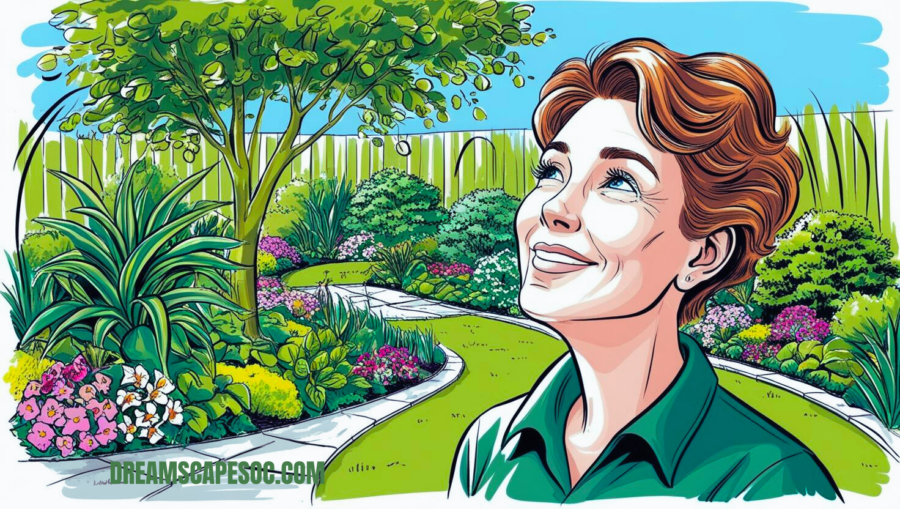What Makes a Cottage Garden So Special?
Cottage gardens have their roots in English countryside homes, where they were designed to be functional and beautiful. They’re known for their lush, complete look, with plants closely packed together to maximize space and create a natural, effortless charm. Unlike formal gardens, cottage gardens are about a relaxed, free-flowing style that celebrates color and texture. They’re also perfect for supporting local wildlife with pollinator-friendly plants and cozy hiding spots.
The cottage garden layout looks wild, with flowers, herbs, and even vegetables interwoven. Each turn feels like a discovery because of the meandering paths and informal borders that replace sharp lines and well-kept areas. The cottage garden style’s ageless beauty and low maintenance appeal make it easy to understand why people are drawn to it.
Elevate Your Outdoor Space—Explore Exclusive Landscaping Concepts
Which Plants Are Best for Your Cottage Garden?
Choosing plants for a cottage garden is all about creating variety. To add height and interest, you’ll want a mix of flowering plants, herbs, edibles, and climbing vines.
Classics like roses, lavender, foxglove, and hollyhocks are essential for flowers. Roses are a perennially elegant addition to any garden and are available in climber and shrub kinds. Another important is lavender, whose aroma and vivid purple hue draw pollinators and provide a lovely contrast to other plants. Foxgloves and hollyhocks, with their tall, striking blooms, add that vertical interest, helping to make the layered look essential to cottage gardens.
Adding veggies and herbs to your garden improves its usability and aesthetic appeal. Imagine collecting fresh mint leaves for tea or passing fragrant sage or thyme in your yard. Another great addition is strawberries, which give a pop of color and a delightful summertime treat. Herbs are simple to cultivate and go well with flowers to create a unique, whole setting. Herbs are simple to cultivate and go well with flowers to produce a distinctive, holistic landscape. Herbs are simple to cultivate and go well with flowers to create a unique, multisensory landscape. Shrubs and climbers help fill in your garden and add some structure. Honeysuckle and clematis are perfect for wrapping around trellises or fences, giving your garden a cozy, enclosed feel. For evergreen structures, consider boxwood shrubs; their compact growth works well as natural borders. And if you want big, beautiful blooms, hydrangeas and lilacs are great choices—they bring color and fragrance to your space from spring through fall.
Transform Your Outdoor Space Today – Download Your Free Landscaping and Gardening Checklist
| Aspect | Details |
| Style | Informal, colorful, and lush; blends flowers, herbs, and edibles. |
| Plants | Roses, lavender, mint, strawberries, and climbing vines. |
| Layout | Winding paths, layered planting, natural borders. |
| Paths | Gravel or stepping stones for a relaxed feel. |
| Charming Touches | Rustic decor, bird feeders, vintage containers. |
| Wildlife-Friendly | Birdbaths, bee-friendly plants, pollinator flowers. |
| Seasonal Care | Prune, compost, mulch, stagger blooms for year-round color. |
| Personal Touches | Repurposed planters, cozy seating areas. |
Planning Your Cottage Garden Layout
Designing a cottage garden layout is more about creating an experience than following rigid rules. Start by planning paths that wind through your garden. Gravel and crushed stone work well for that rustic look, or you could use stepping stones to add a natural, meandering path. These paths help you explore your garden and encourage you to slow down and enjoy the space.
When it comes to arranging plants, think in layers. At the front, use shorter plants like dianthus or lamb’s ear to form a soft edge. Mid-sized plants, such as daisies or herbs, work well in the middle, while taller plants like hollyhocks or sunflowers go at the back. This tiered strategy keeps everything visible while adding depth.
You may create welcoming areas to sit and enjoy your garden by adding focal elements, such as a birdbath or a rustic bench. These accessories give your garden personality and a more inviting environment.

Adding Unique Details and Personal Touches
The charm of a cottage garden shines through in all those tiny, thoughtful touches. Add some rustic pieces, like a wooden arbor or trellis—ideal for letting climbing plants weave through and giving off that timeless cottage vibe. In addition, you may add some cast-iron or wicker chairs to create a welcoming space where you can unwind, take in the beauty of your garden, and sit back.
Extra appeal is added by using vintage containers and décor. Make planters out of old teapots or tin cans, or make a charming border out of old fence. In addition to providing visual interest, handcrafted or historic birdhouses help local birds.
A true cottage garden would seem incomplete without some wildlife-friendly elements. Butterfly-attracting plants, bird feeders, and birdbaths will make your landscape come to life. Pollinator plants like milkweed, marigolds, and coneflowers will attract bees and butterflies and create a lively, buzzing atmosphere.
Seasonal Care and Maintenance Tips
Even though cottage gardens are designed to look relaxed and natural, they still need some seasonal care to stay vibrant.
Pruning and deadheading are key to keeping your garden looking fresh. Regularly remove spent flowers and trim back plants that have grown too wild. Deadheading is especially important for plants like roses, which will keep blooming with the proper care.
Add well-rotted manure or organic compost at least once a year to keep your soil in peak condition. When spring rolls around, give your garden a little kick with a balanced fertilizer or compost. As summer heats up, spread some mulch around your plants to help lock in moisture and keep those pesky weeds under control. Then, when fall arrives, clean up your garden beds and throw on a fresh layer of compost to prepare for the winter months.
If pests are a problem, use natural methods to keep them under control. Companion planting can help deter pests while encouraging beneficial insects like ladybugs, which can make a big difference. Mulching around plants also helps prevent disease by keeping moisture levels stable.
What I Think
Growing flowers is just one element of designing a cottage garden; another is making the area light-filled, useful, and visually appealing. Well-chosen plants, a welcoming design, and those small details can make your garden a year-round joyful place. A well-maintained cottage garden becomes a haven where fresh colors and excitement emerge with each season.
The most important lesson is to layer plants, blend in flowers, herbs, and veggies, and keep an unorganized, organic design in order to create a flowering cottage garden. Use climate-appropriate plants and add rustic accents like bird feeders and vintage décor to create the perfect cottage appeal.
Dive into related articles now for even sharper insights—you won’t regret it!
Seasonal Flower Planting: A Year-Round Guide for Vibrant Blooms
FAQs
How can I attract more butterflies to my cottage garden?
Butterflies love nectar-rich flowers like butterfly bush, lavender, and milkweed. Sunny, sheltered areas also help attract butterflies.
Are cottage gardens high maintenance?
While they’re not as high maintenance as formal gardens, cottage gardens need regular care, such as pruning, deadheading, and seasonal maintenance, to thrive.
What’s the best way to prevent weeds in a cottage garden?
Dense planting helps naturally suppress weeds, but using mulch and ground cover can further reduce weed growth.
How can I make my cottage garden look good in winter?
Include winter-blooming plants like hellebores and some evergreen shrubs for year-round interest, even when it’s cold.
What’s the best way to arrange plants for that layered look?
Place shorter plants at the front, mid-sized plants in the middle, and taller plants at the back to create a layered effect that lets every plant shine.

